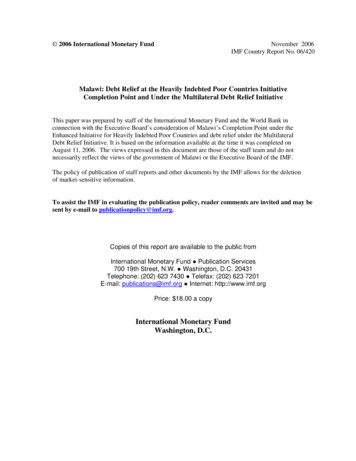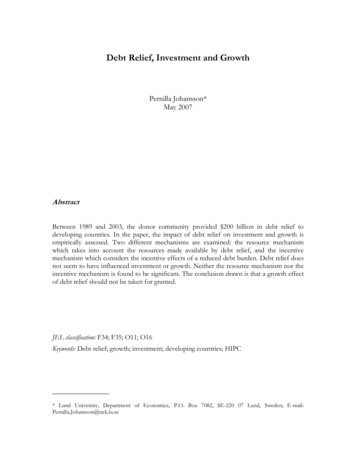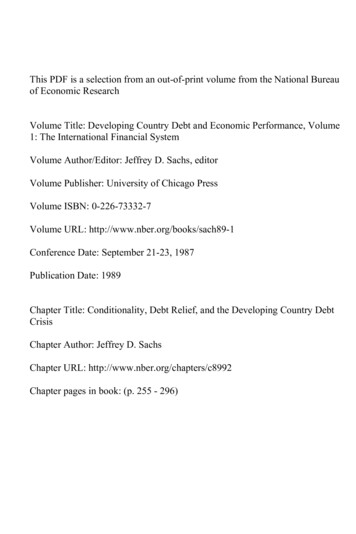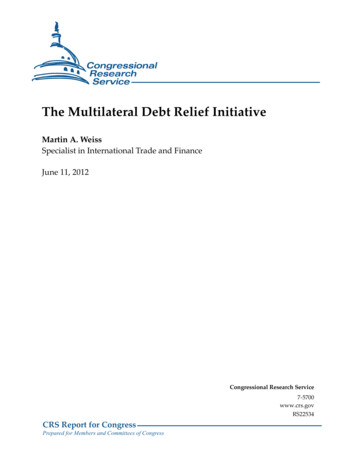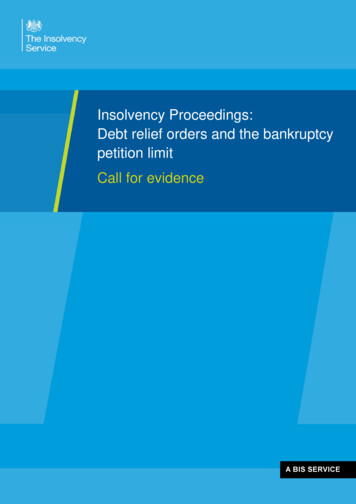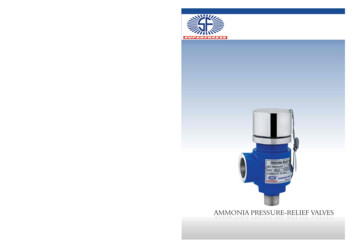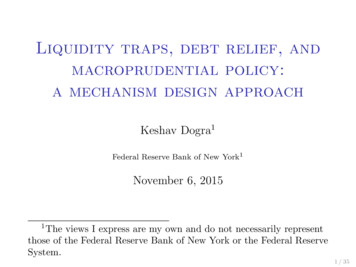
Transcription
Liquidity traps, debt relief, andmacroprudential policy:a mechanism design approachKeshav Dogra1Federal Reserve Bank of New York1November 6, 20151The views I express are my own and do not necessarily representthose of the Federal Reserve Bank of New York or the Federal ReserveSystem.1 / 35
MotivationIIFrequently suggested policy in high-debt recessions:write off debt (HOLC (1933), Iceland (2008))IKeynesian benefits: transfers wealth to high MPCborrowers, boosting demandICost: Encourages overborrowing ex anteAlternative policy: macroprudential regulation toprevent overborrowingIICost: may make borrowers worse offWrite model to ask if debt relief, macroprudentialpolicy areIex ante optimal?IPareto improving?Literature2 / 35
ModelIIPerfect foresight, time is discrete, t 0, 1, .Borrowers and savers, equal measure, preferencesiU (c , θi ) : U(ci0 , θi ) Xβ t u(cit )(1)t 1IIwhere Ucθ 0, θB θS 1.Costlessly produce yti y units of variety i output.Consume an aggregate of all varieties.Constraints:dit 1 1 rtidt 1 φ, t 1, .citdi0yti 0, idit(2)(3)(4)3 / 35
Equilibrium with ZLB rt 0DefinitionA ZLB-constrained equilibrium is {cit , dit , yt , rt } such that1. Each household i maximizes (1) s.t. (2), (3), (4)2. cSt cBt 2yt3. rt 0, yti yt y , rt (y yt ) 0graphNK model4 / 35
Ex ante overborrowingPropositionThere exists θZLB such that if θB θZLB , thenrt 0u0(cS1 ) βu0 (y (1 β)φ)y1 cS1 d1 φ y IKorinek and Simsek [2014]5 / 35
ZLB economicsIResource constraint:cS1 cB1 2y1IcS1 pinned down by savers’ Euler equation:u0 (cS1 ) βu0 (cS2 ) βu0 (y (1 β)φ)IcB1 by borrowing constraint:cB1 y 1 φ d1ISubstituting in:cS1 (y1 d1 φ) 2y1y1 cS1 d1 φ y 6 / 35
Potential gains from transfers?IIImagine unanticipated transfer T from savers toborrowers.IBorrowers better offIIncome increases: y1 cS1 T d1 φISavers no worse off!To restore full employment, need transferT F E : d1 (cS1 φ y )increasing in d1 .IKorinek and Simsek [2014], Farhi and Werning [2013]7 / 35
Equilibrium with date 1 transfersDefinitionAn equilibrium with date 1 transfers is {cit , dit , yt , rt , T̄ }such that, given a transfer function T (d):1. Households maximize (1) s.t. (4), (3), andci1 y1i T (di1 ) T̄ di1 di21 r1S2. cBt ct 2yt3. rt 0, yt y , rt (y yt ) 04. Balanced budget:T (dS1 ) T (dB1 ) 2T̄8 / 35
Full employment transfer maynot be incentive compatible9 / 35
Macroprudential policy withprivate informationIAlternative policy: date 0 debt limit d1 φ0 .IEfficient, Pareto improving under full information(Korinek and Simsek [2014], Farhi and Werning [2013])IUnder private information.10 / 35
Debt limits may not be Paretoimproving11 / 35
Constrained efficient allocationsSocial planner solvesmaxS S B B BcS0 ,c1 ,c2 ,c0 ,c1 ,c2αU (cS , θS ) (1 α)U (cB , θB )(PP) cS0 cB0 2y(RC0) cS1 cB1 2y cS2 cB2 2y cB2 y (1 β)φu0 (cS1 ) βu0 (cS2 )U (cS , θS ) U (cB , θS )(RC1)BSU (c , θB ) U (c , θB )(RC2)(BC)(ZLB)(ICS)(ICB)Solution12 / 35
ImplementationPropositionAny solution to (PP) can be implemented either as anequilibrium with date 1 transfers, or as an equilibrium withdate 0 transfers.graph13 / 35
Date 1 transfers: Debt relief14 / 35
Debt relief implements efficientallocationsPropositionThere exists α(θB ) such that1. debt relief implements the optimal allocation iffα α(θB ).2. If (ICS) binds, α α(θB ) and debt relief implementsthe optimal allocation.ICSgraph15 / 35
Debt relief is Pareto improvingat the ZLBIDebt relief is always ex ante Pareto optimal.IWhen is it ex ante Pareto-improving?Proposition1. If θB θZLB , the competitive equilibrium is Paretoinefficient. Debt relief is always Pareto improving.2. If θB θZLB , the competitive equilibrium is Paretooptimal. Debt relief is not Pareto improving.graph16 / 35
Pareto improving debt relief17 / 35
Pareto improving debt relief18 / 35
Targeted loan support programsDefinitionT0 (d) is a targeted loan support program (withmacroprudential tax) if it has the formT0 (d) T̄ if d d T τ d if d d for some T̄, T 0, τ .Implements same allocation as debt relief with a capI always efficient, ex ante Pareto improving at ZLB19 / 35
Targeted loan support programs20 / 35
ConclusionDebt relief with a cap (or loan support plusmacropru tax) is Pareto improving at the ZLB.Fiscal and macroprudential policy can be substituteswhen monetary policy is constrained.In paper: results robust to1. continuous distribution of types2. aggregate uncertainty3. different sources of heterogeneity4. labor supply21 / 35
Key ingredients1. Agents differ in preference for borrowing/saving(impatience), which is private information.IHeterogeneity distribution of debtIPrivate information incentives matter2. Zero lower bound constrains interest rates.IOutput demand-determined, role for fiscal policy3. Exogenous contraction in borrowing constraint.IAggregate demand shockIIntroduces MPC heterogeneityWrite Pareto problem, solve for optimal transfer policy.back23 / 35
Results1. Unconditional transfer to borrowers is Paretoimproving ex post, but not ex ante.2. Macroprudential debt limit is Pareto improving underfull information, but not under private information.3. Ex ante optimal policy can be implemented with eitherdebt relief with a cap, or with macroprudential taxesplus targeted loan support programs.4. When ZLB binds, debt relief (or loan support) is exante Pareto improving. In normal times, purelyredistributive.24 / 35
Related LiteratureIDeleveraging and ZLB (Eggertsson and Krugman[2012], Guerrieri and Lorenzoni [2011]): I ask what isoptimal policyIEx post benefits of debt relief (Fornaro [2013]), andex ante benefits of macroprudential policy (Korinekand Simsek [2014], Farhi and Werning [2013]): I addprivate information, study tradeoffsIOptimal taxation and screening (Mirrlees [1971], Saez[2001]): macroeconomic externality, new motivefor redistributionback25 / 35
Equilibrium with ZLB rt 0back26 / 35
New Keynesian modelIPreferences u(Ct v(ht ))ICt Dixit-Stiglitz aggregate of varieties j produced byfirms with technology yt (j) ht (j)IPrices identical and fixed: Pt (j) P 1IMonetary policy sets it to ensure efficient outputv 0 (ht ) 1, unless constrained by ZLB it 0IResult: isomorphic to ZLB-constrained equilibrium,defining ct Ct v(ht ), y maxh h v(h).back27 / 35
Equilibrium with date 0 transfersDefinitionAn equilibrium with date 0 transfers is{cit , dit , yt , rt , T̄0 } such that, given a transfer function T0 (d):1. S, B max (1) s.t. (3) andci0 y0i di1 T0 (di1 ) T̄01 r1S2. cBt ct 2yt3. rt 0, yt y , rt (y yt ) 04. Balanced budget:T0 (dS1 ) T0 (dB1 ) T̄028 / 35
Constrained efficient allocations1. (ICS) binds in allocations favorable for borrowers;(ICB) binds in allocations better for savers. graph2. When θB large, (ZLB) binds.graph3. In general, full employment, even if (ZLB) binds. Butunemployment may be constrained optimal if (ICS)also binds. graphback29 / 35
Constrained efficient allocationsback30 / 35
Constrained efficient allocationsback31 / 35
Constrained efficient allocationsback32 / 35
Implementationback33 / 35
Date 1 transfers: Debt reliefDefinitionT (d) is a debt relief transfer function if it has the formT (d) T̄ if d d T̄ (d d) if d [d, d] if d d T̄ (d d) τ (d d) for some T̄ 0, d, d d, τ . 34 / 35
Debt relief implementsallocations in which (ICS) binds35 / 35
Motivation I Frequently suggested policy in high-debt recessions: write o debt (HOLC (1933), Iceland (2008)) I Keynesian bene ts: transfers wealth to high MPC borrowers, boosting demand I Cost: Encourages overborrowing ex ante I Alternative policy: macroprudential regulation to prevent overborrowing I Cost: may make borrowers worse o I Write model to ask if debt relief, macroprudential
